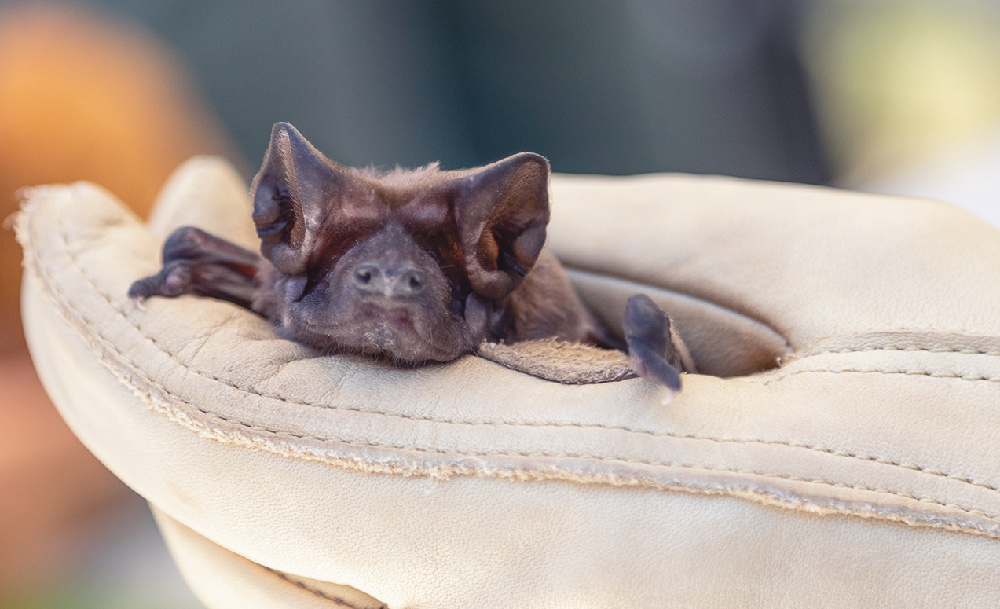
Florida Bonneted Bat
Binomial
Family
Colony size
Weight
Wingspan
Diet
Status

f you were to spot an Endangered Florida bonneted bat (Eumops floridanus) one evening, the first thing you’d notice about it would probably be its size. It’s the largest bat in the state, with a wingspan of roughly 20 to 21 inches. There isn’t much of a difference in size between the males and the females, so you probably wouldn’t be able to tell, at least from a distance, what sex you spotted.
But as it flew above you, looking for insects to eat, you might also notice the peculiar shape of its ears. The bats really do look like they’re wearing little, furry, bat-sized brown bonnets.
The bats are unique to Florida, which is the only place in the world where this endemic species lives. In fact, they only live in the lower half of the state, roughly from south of Orlando to the tip of the peninsula, in four distinct population groups.
“Like the American crocodile and mangroves, Florida bonneted bats’ northern range is restricted by temperature,” says Bat Conservation International (BCI) Endangered Species Interventions Research Fellow Dr. Melquisedec Gamba-Ríos. “Because they’re cold intolerant, the frost line limits their range. Of all the bats in the country that are Endangered right now, the Florida bonneted bat has the smallest range distribution.”
This means threats they encounter could significantly impact all populations of the bat. To promote a successful recovery and long-term conservation strategy for the species, Dr. Gamba-Ríos points out it is important to focus on both natural and human-related habitats for the bat.
Four distinct populations
The researchers found low levels of “gene flow” in this Miami population, meaning the bats are mating within their own population, rather than mixing with other populations. This could put them at even greater risk of extinction.

Helping bats find safe roosting sites
The species’ preferred roosts include larger cavities in pine and cypress trees since they can usually comfortably fit in them. Unfortunately, these large cavities are becoming harder to come by. Dr. Gamba-Ríos says only 17% of the natural forests the bats use are left in the range, and less than 2% of these trees have cavities, but only a few of them have the characteristics that the bats prefer.
But there is good news. While the bats prefer specific cavities, they’re not too picky overall, and they are amenable to using human-made roosting sites if they meet their needs. Sometimes, they will find cavities in the urban environment to use, and other times, they will use special bat houses designed just for them.
—Dr. Melquisedec Gamba-Ríos
His team recently studied three different designs for bat houses. One resembles a tree crevice, and a second looks like a traditional bat house. A third “Rocket Box” features two chambers, designed to protect bats from cold temperatures in the winter and, more importantly, extreme heat in the summer. As temperatures rise due to climate change, overheating is becoming more and more of a concern.
Of the three options, researchers found the “Rocket Box” provides the most stable temperature for the bats. So far, Dr. Gamba-Ríos’s team has set up 15 bat houses with the design, which quickly proved popular. It took only three weeks for bats to occupy the first one. Now, 136 Florida bonneted bats around the Miami area call these boxes home.
Protecting an Endangered species isn’t easy. It involves a number of measures to support its recovery and conservation, including efforts to minimize human-bat conflict and provide safe roosting sites. However, with scientists and conservation partners working to help the Florida bonneted bat populations recover, Dr. Gamba-Ríos says he’s hopeful for the future and confident the team’s efforts are paying off.